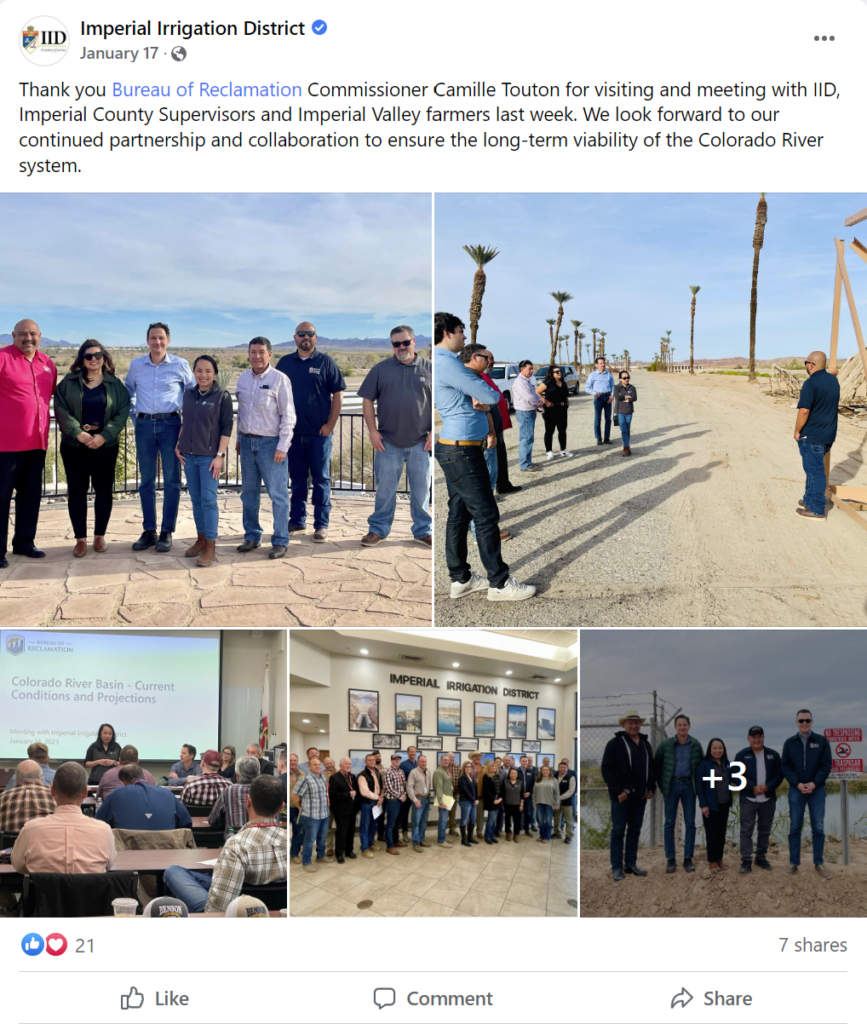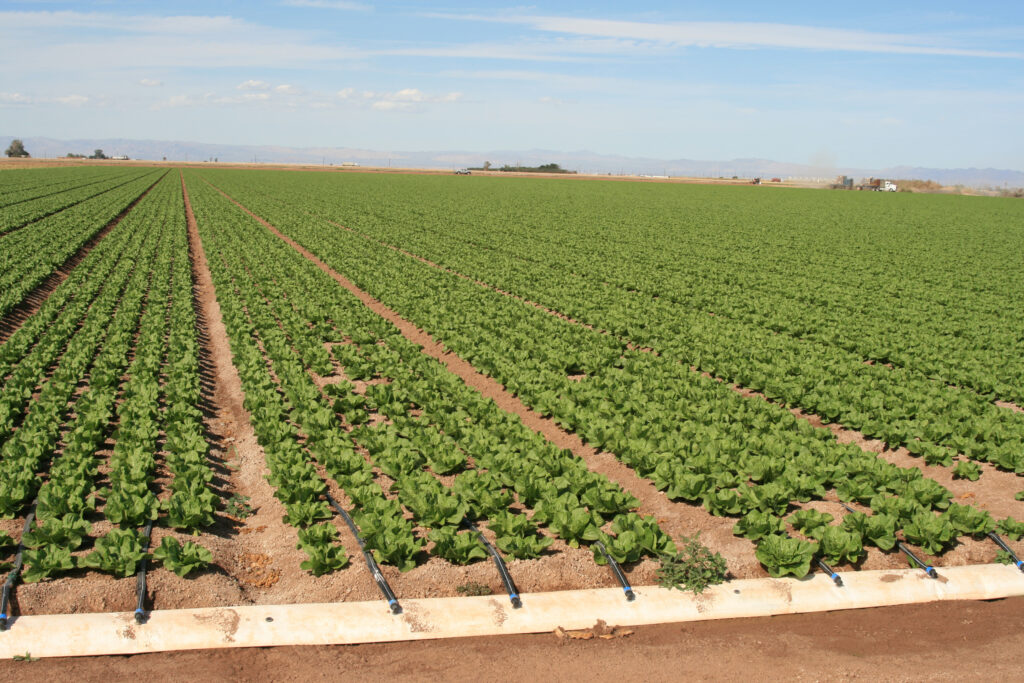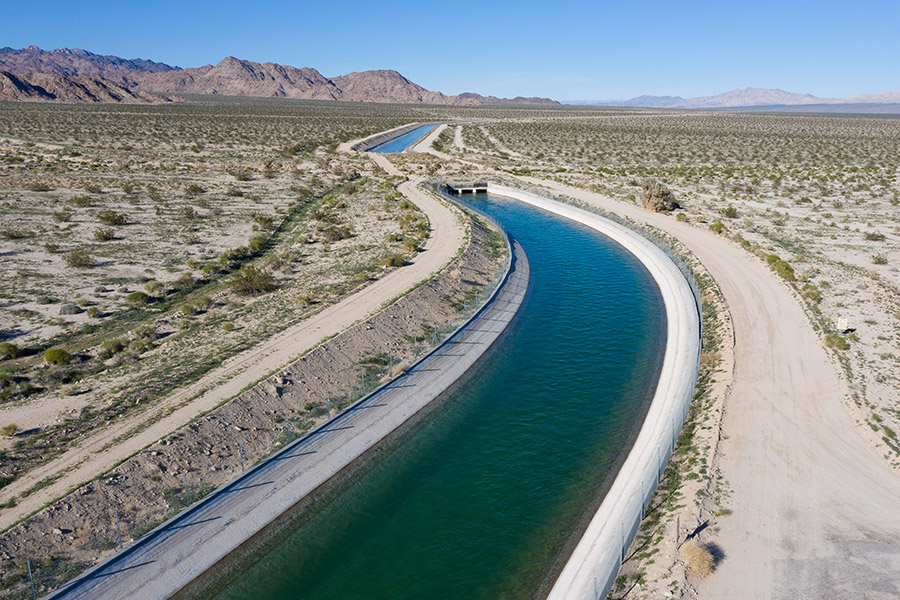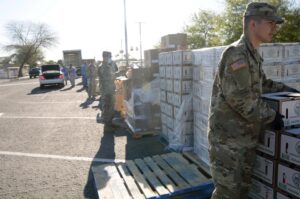THIS IS WHAT SUCCESS LOOKS LIKE ON THE
COLORADO RIVER

Formula for Preserving the Colorado River for All Who Depend on it
Beginning with strategies proven successful in the Imperial Valley
Preserving the Colorado River
Invest in Aggressive Conservation Along the Lines of the Successful Strategies Implemented by the Imperial Irrigation District
The Imperial Valley has deployed a myriad of conservation measures over the years and continuously adds new strategies as technology develops. Because of those efforts, the Imperial Irrigation District now conserves an average of 500,000 acre-feet of water every year, totaling over 7 million acre-feet since 2003, and still produces the food our country depends on.
Additionally, the Coachella Valley Water District,  Metropolitan Water District of Southern California, and Palo Verde Irrigation District have all employed local conservation measures that also help reduce dependence on the Colorado River. They include rebates for residential and commercial water conservation, turf replacement programs, limited farmland fallowing, and more.
Metropolitan Water District of Southern California, and Palo Verde Irrigation District have all employed local conservation measures that also help reduce dependence on the Colorado River. They include rebates for residential and commercial water conservation, turf replacement programs, limited farmland fallowing, and more.
Over the last 20 years, urban partnerships in on-farm water conservation have been a model of success in creating dependable domestic water supplies while enhancing the efficient production of fruit, vegetable, and forage products that feed America. The quantity of savings that is now on the table creates up to a 28 percent reduction in usage of Colorado River water in California.
Utilizing California’s experience in the other Colorado River states, with financial help from the federal government to make it happen, is the keystone of success on the river. Urban areas also need to invest in on-farm conservation to free-up water supplies that should have been developed to meet the increased demands from population growth.
Henry Martinez, Imperial Irrigation District General Manager
Ensure
All States Contribute Their Fair Share
Even with state-of-the-art conservation, all of us need to do more. That’s why California, despite its senior water rights, was the first to offer additional cuts which are laid out in the California SEIS Modeling Framework presented to the Bureau of Reclamation.
For collaboration to continue, the new cuts must be spread among all Colorado River states.
California Puts 750,000 Acre-Feet of Water on The Table
On October 5, 2022, the Colorado River Board of California pledged up to 400,000 acre-feet of water per year in new conservation, which follows a commitment to contribute up to an additional 350,000 acre-feet of water per year of  Intentionally Created Surplus, or ICS. ICS is part of the 2007 Guidelines, which were expanded in 2019 during Drought Contingency Plan agreements among Upper Basin and Lower Basin states to protect the Colorado River.
Intentionally Created Surplus, or ICS. ICS is part of the 2007 Guidelines, which were expanded in 2019 during Drought Contingency Plan agreements among Upper Basin and Lower Basin states to protect the Colorado River.
Participating public water agencies implemented local water conservations programs that would reduce demand on the river to create a temporary surplus in Lake Mead to prevent a continued decline in lake levels. Under the Drought Contingency Plan rules, ICS-conserved water would have been drawn from the lake by each contributing agency during the following year.
California pledged to forego its access to ICS water with the goal of further protecting water levels in Lake Mead, and is the only state, so far, to do so.
ICS was an important part of the agreements among Basin States that respected existing water rights and priorities.
Commit to Protecting a Safe, Affordable, Domestic Food Supply
It has been noted that agriculture uses a significant amount of the water throughout all the Colorado River states and it’s critical that state and federal partners continue to honor that commitment. Maintaining a robust domestic food supply is particularly important now with so much unrest throughout the world.
 In a commentary published in the Desert Sun, Imperial Valley farmer and IVH2O board member, Stephen Benson, defended the Imperial Valley’s use of water, explaining that the Valley’s conservation practices reduce demands on the Colorado River while still growing vast quantities of food for families across the country.
In a commentary published in the Desert Sun, Imperial Valley farmer and IVH2O board member, Stephen Benson, defended the Imperial Valley’s use of water, explaining that the Valley’s conservation practices reduce demands on the Colorado River while still growing vast quantities of food for families across the country.
Stephen Benson, Imperial Valley Farmer

The Western United States produces food more efficiently than almost any other location, and as new water conservation measures are put in place, that efficiency will continue to grow. States west of the Rockies produce more than 80% of our domestic fruits, nuts and vegetables, much of which is dependent on the Colorado River.
Growing food at home is water-efficient, keeps food available without depending on unstable foreign sources, is safer than food from many other locations, and protects the environment by cutting down on food transportation.
“You’ve got to . . . keep listening to the farmers, because ultimately, you don’t want to get to the point of creating a food crisis to solve a water crisis.”
Henry Martinez, Imperial Irrigation District General Manager
Read more at The Palm Springs Desert Sun
Respect Existing Water Rights
Upending more than 100 years of established law will not fix the situation on the Colorado – it will simply delay real solutions for years and likely doom any chance of success.
The Bureau of Reclamation is no stranger to solving difficult water rights problems. As it built the Friant Unit in the initial stages of the Central Valley Project, legal obligations to senior waters holders on the San Joaquin River had to be settled.
The solution?
Water supplies used by senior water rights holders were needed to serve the new Friant Unit on the San Joaquin Valley’s Eastside. They were exchanged for supplies delivered by Reclamation from Northern California reservoirs to water districts, now referred to as the “Exchange Contractors”.
Despite this practical solution, and in times of shortage, such as what is currently happening on the Colorado River, those senior water rights holders continue to maintain their priority position as senior water rights holders, and are first in line to receive San Joaquin River water when supplies run short.
A History of Collaboration
The Upper and Lower Colorado River Basins have 100 years of collaboration on the river, and it is all enshrined in The Law of the River, a cooperative effort between states that has been developed over time, proving there is a way to integrate existing water rights law with changing conditions.

The water supply issues we’re facing today are not new and collaboration has been an effective tool in years past.
The Colorado River’s governing system is a result of that collaboration and is a reflection of a century of working together.
As the Bureau of Reclamation explains it,
“The Colorado River is managed and operated under numerous compacts, federal laws, court decisions and decrees, contracts, and regulatory guidelines collectively known as the “Law of the River.” This collection of documents apportions the water and regulates the use and management of the Colorado River among the seven basin states and Mexico.”
Conditions may be drier, but water leaders in the past have recognized challenges and drawn up ways to divide fluctuating resources. Even now, California has stepped up to the plate with up to 750,000 acre-feet of voluntary curtailments as a collaboratively measured response.
Help Existing Cities Meet Citizens’ Needs in the Face of Less Supply
Currently, much of Imperial Valley’s  conserved water is sent to families in urban Southern California.
conserved water is sent to families in urban Southern California.
Five hundred thousand acre-feet of water conserved each year by the Imperial Irrigation District supplies, on average, enough water for the domestic needs of 4.3 million Southern California families annually.
Water for those families must come from somewhere, and these conservation efforts take pressure off other parts of the system.
The federal government can help other basin states achieve similar results, further stabilizing the system for all water users. On October 12, 2022, the Department of Interior announced new drought mitigation funding opportunities to improve and protect the long-term sustainability of the Colorado River System.

Lower Basin States now have access to funds for projects that will achieve the kind of on-farm water conservation practices that have succeeded in California for more than 20 years.
In addition, according to the Department of Interior, it is also working to invest in long-term system efficiency improvements across the Basin, including at least $500 million in the Upper Basin states of Colorado, Utah, Wyoming and New Mexico, that will result in additional water conservation for the entire system.
Protect the Sole Water Supply for the Imperial Valley
The Imperial Valley’s sole water supply is the Colorado River.

Unlike other Basin States, alternate surface supplies or groundwater simply don’t exist to meet the domestic water needs of Imperial Valley residents, or water for the local businesses they depend on, including agriculture.
According to the State of California Employment Development Department, Imperial County’s unemployment rate was 15.6 percent in February 2023, down from a revised 16.2 percent in January 2023, and above the estimate from the prior year of 13.4 percent.
This is a shocking comparison to the unadjusted unemployment rate of 4.8 percent for California and 3.9 percent for the nation during the same period, and 38 percent higher than Yuma County in neighboring Arizona.



